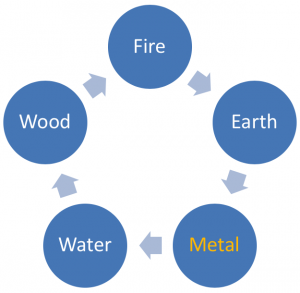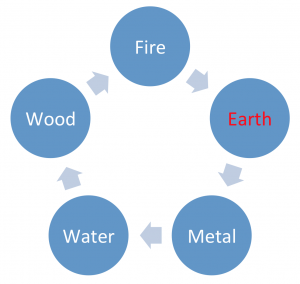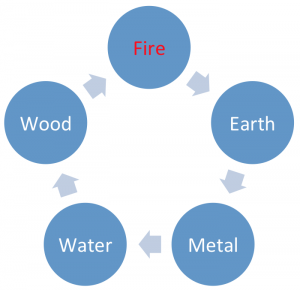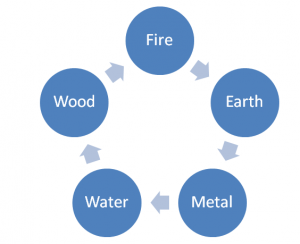Our final blog on the five elements focuses on the Metal element. It houses our Vitality, the bodily soul or ‘Po’ in Chinese, ‘魄’. In Chinese medicine theory, one with a balanced Metal element will have positive direction in life, optimism, and stability. On the other hand, one with a weak Metal element tends to hold on to things, not letting go, and may exhibit pessimism, sadness and grieving.
In the element chart shown below, Earth supports Metal, Metal feeds Water, Metal controls Wood, and Fire controls Metal. They have an interlocking relationship; should one be out-of-balance, it will undermine the other elements. For example, if the heart has too much fire, such as damp heat, it can weaken the lungs. If the lungs are weakened, then the lung chi cannot descend to support and anchor the kidney chi. When the kidney is too yang, it damages kidney yin. The rising kidney yang can cause insomnia and hypertension.
In the regenerative cycle of the Five elements, dry wood in the forest is very flammable when lighting strikes, so fire consumes wood, the forest, and turns wood into ash, ash becomes earth; during bush fire, a tremendous amount of heat is created and vapours rise into the atmosphere and transform into cloud; as the vapours becomes heavier and heavier, it condense into rain drops. Plants need moisture to survive and turn into wood or forest, and hence the process repeats itself.
In the control cycle, a metal chainsaw or axe is used to cut down wood; wood breaks down earth and consumes nutrients in earth to thrive; water is gathered by reservoir built from earth, so earth contains water like rivers and creeks. Water is used to put out fire so it controls fire. Metal is controlled by fire because metal melts by fire to form liquid.

The Metal element consists of the Lungs and Large Intestine, its meridian channels and vital pressure points. The functions of the Metal element are respiration and regeneration through exchange and elimination. The lung is in charge of the whole body’s Chi intake. Fresh oxygen is inhaled through the nose or mouth, down the throat into the trachea, it then fills up the lung’s left and right bronchi, the bronchioles, and then the alveoli. Each alveolus is covered by a network of fine blood vessels call capillaries. This process of respiration is called inspiration, breathing in with oxygen. The heart pumps deoxygenated blood to the lung’s capillaries to exchange for oxygenated blood to pump back to the heart and to the whole body. A waste product of this process, carbon dioxide, is then exhaled through the mouth and the nose. This process of respiration is called expiration, breathing out carbon dioxide. This respiration process is smooth and effortless when the lungs are in good order. The other role of the lung is to transform oxygen air into liquid vapour and circulate this water vapour throughout the whole body to moisten the skin and body hair. Lush and shiny body hair indicates healthy lungs: the lung rules the external body hair. It also regulates the body temperature by sweating out through the sweat glands. When the lung is weak, it can either produce too much sweat or too little sweat.
According to Chinese Medicine Theory, the lung meridian links to the nose via the throat, its primary corridor. Sinus problems, nose congestion and too much mucus and phlegm in the throat might indicate weakness of the lungs. The over production of mucus in the lungs can be due to the inflammation of the lungs. Excess mucus is produced to trap germs and prevent harmful particles entering through the nose or mouth. Common diseases associated with lung infections are asthma, profuse coughing of phlegm, pneumonia, tuberculosis, and bronchitis. Lung diseases can be caused by toxic mould, chemicals in the air, asbestos, bacteria or air born virus, passive smoke, Tobacco smoking, and allergens such as pollen, pet fur and dust.
The metal element meridian channels are mostly on the hands, arms, front of shoulders, front of the neck and beside the nose. The tissue that metal element governs are the skin and membranes. The sense organ for metal is the nose, the sense is smell, physical manifestation is skin and body hair, the body skin colour is white or pale when it is out of balance, its body odour is a rotten smell, and it produces excess mucus when it’s out of tuned. The weather season for the metal element is autumn, the damaging climate for metal is dryness. The direction for metal is west. According to Chinese Medicine Clock, the lung occupies the time of day from 3am to 5am. The large intestine covers the time of day from 5am to 7pm; these are the prime time to nourish one’s metal element. The metal element likes pungent flavours, but too much spice can damage the heart due to excessive heat. Negative emotions for the metal element are grieving, sadness, pessimism and not letting go; positive emotions for metal are optimism and positive direction in life. Coughing occurs when the metal element is not running smoothly. The body parts that related to metal element are shoulders, abdomen and chest. The metal element also controls the body’s respiratory system.
We can learn a great deal from the cycle of the four seasons. Autumn is the season for the metal element. Trees and plants blossom in spring, the beginning of the growth cycle, followed by the fruiting cycle in late summer, then the harvest time. As the trees and plants enter the autumn season, they go bare, they let go of the last year’s foliage and produce. Some trees’ foliage will put on spectacular autumn colours, and maturate fruits are picked by the farmers. In late Autumn, deciduous trees shed leaves and mulch the surrounding earth, fertilise the soil to promote new growth for next year’s harvest. This natural cycle teaches us about the cycle of regeneration and letting go. In with the news and out with the olds, don’t hold onto what we have created or collected from the past, our negativities, old habits, or old bad memories. We must learn from nature to let go of the waste and create room for the news, new energy, new ideas and new directions.
The emotional symptoms that indicate an out-of-balanced Metal element are holding on to the past, not letting go of old possessions, pessimism, excessive grieving, depression, living in isolation and negativities, anti-social, feeling worthless. The physical symptoms that indicate an out-of-balanced metal element are tight chest, shortness of breath, sinus congestion, a running nose, sore throat, asthma, coughs, colds, bronchitis, pneumonia, and constipation.
The Metal element consists of two organs, the large intestine (colon) and the lungs. The large intestine is the yang organ and the lung is the yin organ. The lung meridian consists of 11 pressure points and is the shortest meridian. The first point of the lung meridian Lu 1 starts from the chest, located about 2.5cm below a depression under the lateral end of the clavicle. Lu 2 is where the depression is, 2.5cm up from Lu1. The meridian then travels down the front of the bicep; Lu 3 is about 4 fingers down measured from the deltoid, Lu 4 is 1 thumb down from Lu3. Lu 5 located in the most lateral depression in the elbow fold, on the radial side of the tendon. Lu 6 is about the middle of the forearm on the radial side. Lu 7 located on the radial side of the arm, in the depression about 2 fingers width above the end of the wrist fold. Lu 8 is one finger width down from Lu 7. Lu 9 is located on the radial side of the wrist in the depression at the lateral end of the wrist fold. Lu 10 is located in the middle of the radial edge of the first metacarpal bone, the fleshy bit of muscle. Lu 11 is located at the radial corner of the thumbnail.
The important pressure points on the lung meridian are: Lu 1 for clearing phlegm in the lung and shoulder problems, Lu 5 for treating tennis elbow, clearing heat and cold from the lungs, Lu 7 to recharge the lungs, Lu 9 known for treating sore throat and chest cold. Lu 10 for treating sore throat and clearing heat from the body. Lu 11 for stimulating the flow of energy in the lung meridian.
The functions of Large Intestine are transformation, transportation and elimination of waste products from the foods consumed. It is about 1.5 metres long, sitting in the lower abdominal cavity. A healthy colon will work with the lungs seamlessly in the exchange and elimination processes to eliminate its waste products and toxin daily, sometimes once or twice a day to clean out the system and help to unblock Chi and promote deep inhalation. The colon also produces friendly bacteria which helps breaking down food fibre. These friendly bacteria are store in the Appendix.
When the large colon is out of balance, one might experience cold lower abdomen, bloatedness, constipation, diarrhoea, haemorrhoids from constipation, shallow breathes, skin problems and lack of energy. Emotionally, one might experience difficulties in self-expression, letting go of negative thoughts and resentments, and holding on to clutters and possession.
In Traditional Chinese Medicine theory, the chewing process is very important when we ingest our foods. The TCM theory beliefs that, by chewing our food thoroughly, it activates the large intestine meridian and promotes a healthy function of the large colon. It is recommended by the TCM theory to chew our food 32 times before swallowing it.
There are 20 points on the Large Intestine meridian. It begins on the index finger, from the radial corner of the fingernail LI 1, then the points travel up the anterior lateral aspect of the arm. LI 2 is located on the head of the metacarpal distal to the body; LI 3 is located on the head of the metacarpal proximal to the body; LI 4 is located on the base of the metacarpal, the highest point of the web of flesh between the thumb and the index finger; LI 5 is located on the joint of the carpal and radius, on the radial side of the wrist. LI 6 to LI 9 runs along the radius on the anterior lateral aspect of the forearm; LI 10 located 3 fingers width below the elbow fold; LI 11 located at the lateral end of the elbow fold; LI 12 located on the elbow joint on the head of the humerus bone distal to the body. LI 13 is located 4 fingers width up from the elbow fold, about the middle of the bicep; LI 14 is located on the depression that separate the deltoid and the bicep muscle on the radial side of the shoulder; LI 15 is located on the depression of the joint that connects the humerus bone, the clavical bone and the scapula socket; LI 16 is located on the upper aspect of the shoulder, in the depression between the adjacent extremity of the clavicle and the scapular bone; LI 17 is on the depression just above the end of the clavical bone proximal to the mid-line of the body. LI 18 is located 2 fingers width above LI 17; LI 19 is located diagonally over the front of the neck and jaw to the corner of the nose on the maxilla bone just below the nostril; and LI 20 located just on the corner of the nostril.
The vital pressure points on the Large Intestine meridian are: LI 1 for activating the entire meridian, and can also be used for treating sore throat; LI 4 can be used to treat toothache, promote bowel movement, stimulate body immunity and increase energy level; do not work on LI 4 during pregnancy; LI 5 can be used for treating sinus problems and low energy; LI 10 is a major point for treating problems with the arm and shoulder, but should not be used in pregnancy; LI 11 can be used for constipation and tennis elbow; LI 16 can be used for treating frozen shoulder and shoulder stiffness; LI 20 can be used for treating all sinus problems.
Foods that are good for nourishing Lungs are duck, cow milk, pork, cheese, walnut, pine nut, pistachio, rice, ginkgo nut, almond, apricot, tangerine, yam, strawberry, watermelon, pears, asparagus, dairy and apples. Foods that are good for counteracting phlegm heat in the lungs are chrysanthemum, lily bulb, lyceum fruit, Chinese ginseng, citrus peel, astragalus, American ginseng, carrot, grapefruit, watercress, cabbage, celery and cucumber. Foods that are good for treating phlegm cold in the lungs are mustard seed, pepper, ginger, onion, garlic coffee, peanuts cherries, peach and eggs. Foods that are good for nourishing Large intestine are broccoli, banana, eggplant, lettuce, parsnip, potato, rhubarb, spinach, almond, fennel seed, sesame, walnut, and pine nut.
Exercises that can help to strengthen the Metal element are swimming, walking, Tai Chi, meridian stretches, Pilates, walking meditation, weight-based workouts, cycling, yoga and deep breathing exercise.
Regular shiatsu massage can promote blood circulation and energy flow to release physical tension and emotional stress within the body and harmonise the organs and its meridians in the Metal element.
Benefits of the Meridian Stretches
Regular practice of Meridian stretches can increase your muscle tone, body flexibility, immunity, blood circulation, promote the smooth flow of energy in the twelve meridian channels and nourish each of the internal organs.
Lung Meridian (3am-5am)(yin)(Metal )
Stand with your feet shoulder width apart, place your arms behind your back, cross your thumbs and inhale through your nose, allow air travel to your lower abdomen. Bend your body forward, and raise your arms as high as possible and exhale. Repeat this process 12 times. Each time, pay attention to your lung meridian and visualise the lung meridian is filled with fresh energy.
Large Intestine Meridian (5am-7am)(yang)(Metal )
Raise one of your legs and step forward to form a 90 degree angle, leave the other leg to form a straight line in an incline angle, then rise your arms above your head, title your head back and inhale; exhale as you bring back in the leg that was stepped out to form the 90 degree angle. Repeat this for the other leg and perform the sequences for 12 times.




